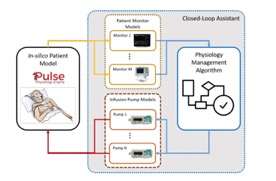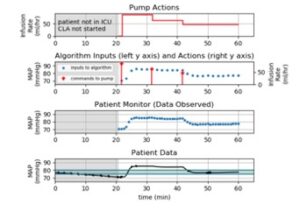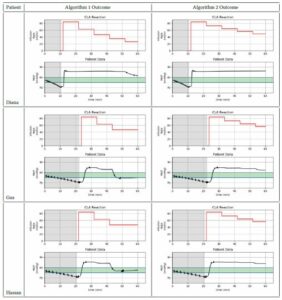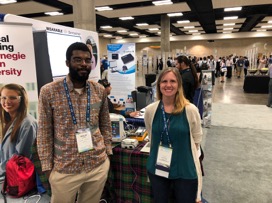Pulse Physiology used for Testing and Validation of a Closed-Loop Physiology Management System


CLAs with in-silico patients.
The Pulse Physiology team has been working with Dr. Philip Asare and Farooq Gessa from Bucknell University and Dr. Mark Poler from Geisinger Health to integrate patient physiology into a test bed for a closed-loop patient physiology management system. This work has resulted in a publication at the Medical Cyber Physical System Workshop in Porto, Portugal on April 10, 2018.
Paper Abstract: Towards A Test and Validation Framework for Closed-Loop Physiology Management Systems for Critical and Perioperative Care
Farooq Gessa, Philip Asare, Aaron Bray, Rachel Clipp, and S. Mark Poler

Many medical devices come equipped with a communication interface. Over the years, there has been interest in leveraging these interfaces to add computers to the loop to aid in decision making and automatic application of interventions. Such systems, which we call Closed-Loop Assistants (CLAs), are intended to help clinicians manage the cognitive load that can arise as the complexity of patient management increases. We present an open-source framework for examining CLA-patient interactions through software simulations of the CLA with in-silico patients to enable early testing and validation of proposed physiology management strategies. We show how this framework can be used to test different strategies across a small patient population. Considering a patient population is important because inter-patient variability is one of the critical factors that can hamper the ability of a medical cyber-physical system like the CLA to meet its goals. The ability to explore this variability early in the design process therefore helps us in increasing robustness of the system.


Engineering in Medicine and Biology Conference 2018
Dr. Rachel Clipp and Dr. Philip Asare attended the Engineering in Medicine and Biology Conference in Honolulu, HI July 17-22, where they presented this and other work. Dr. Asare provided a demonstration of the prototype testbed with Pulse Physiology vitals signs reflected on the patient monitor. The mean arterial pressure values calculated by Pulse are the inputs to the algorithm that determines the amount epinephrine required for infusion. The infusion rates from the pump are then fed back into Pulse to close the loop and to observe the patient response to the algorithm’s decisions.

Future Collaboration
Our future plans include advancements to the patient physiology to improve response to various interventions and contexts. We also plan to expand the clinical scenarios and algorithms to improve the framework for testing of closed-loop systems. We are interested in developing a wide variety of patient types that can be used as a patient population for testing medical devices and their associated algorithms prior to human testing. This is key for the inter- and intra-patient variability shown in Figure 4. It will be critical to develop approaches for testing as these closed loop systems gain momentum in patient care, . The addition of a physiology engine, such as the Pulse Physiology Engine, is key to the development of these test beds.
To learn more about Kitware’s open source physiological modeling development efforts, please contact physiology@kitware.com. To learn more about the work on closed-loop systems, and the test framework, please contact Philip Asare (philip.asare@bucknell.edu).